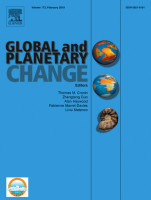“The driver of the Early–Middle Triassic biotic recovery on land following the end-Permian crisis is puzzling. Here, we show the biotic recovery was gradual and spanned up to 8 Myr after the end-Permian mass extinction, based on continuous, well-dated sections over large areas in the northeastern Ordos Basin, North China. Initial recovery began in the Olenekian, marked by the disappearance of microbially induced sedimentary structures and reappearance of bioturbation, and continued in the Anisian, with a bloom of plants and tetrapods and intense bioturbation. Sedimentary environments changed from Induan braided-eolian conditions to Olenekian–Anisian shallow lacustrine and meandering river systems, marking an overall deepening lacustrine system. Carbonate δ13C and geochemical proxies of weathering intensity, salinity and clayiness reveal an overall warm and semi-humid paleoclimate in the Olenekian–Anisian. This improved stable paleoenvironment of warm and semi-humid conditions likely contributed to the biotic recovery following the Permian-Triassic hyperthermal-related crisis. read more

